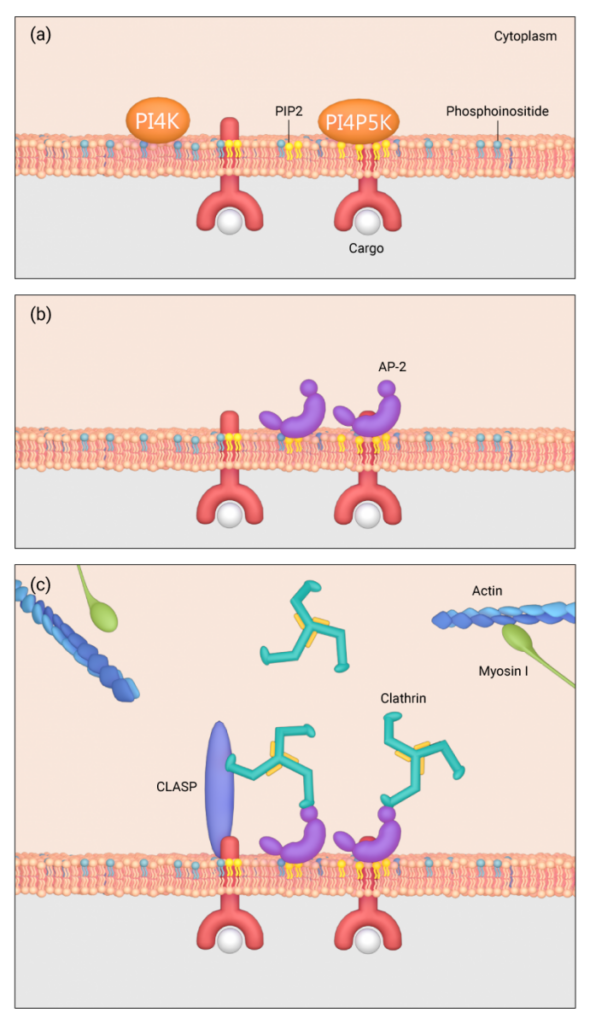How is clathrin recruited to the plasma membrane?
Clathrin-mediated endocytosis is triggered by phosphatidylinositol-4,5-bisphosphate (PIP2) accumulation within the plasma membrane. PIP2 accumulates as a result of phosphoinositide catalysis by the lipid kinases, phosphatidylinositol-4-kinase (PI4K) and phosphatidylinositol-4-phosphate-5-kinase (PI4P5K) [1], [2] and hydrolysis by phosphatases. The adaptor proteins (AP-2 in mammals or Sla1 in budding yeast) collapse on PIP2 in a stochastic manner and form an adaptor-PIP2 complex. The complex is stabilized by accessory proteins, such as clathrin-associated sorting proteins (CLASPs) [3], actin and myosin I [4][5][6]. AP-2 is autoinhibited in the cytosol when the levels of PIP2 or cargo are low. This prevents inappropriate clathrin recruitment. Binding of PIP2 and cargo to AP-2, which results from PIP2 accumulation, activates AP-2, allowing the complex to bind clathrin. The presence of cargo further stabilizes the nucleation process [7]. The mechanism by which certain sites are chosen for endocytosis is not clear. In budding yeasts, large immobile assemblies of proteins on the plasma membrane called eisosomes have been identified. Eisosomes mark the sites of endocytosis, and are primarily comprised of two proteins, Pil1 and Lsp1[8].

(a) Phosphoinositide catalysis by lipid kinases (PI4K and PI4P5K) accumulates PIP2, (b) AP-2 collapses on PIP2 and form an adaptor-PIP2 complex, (c) various accessory proteins such as CLASPs, actin and myosin I stabilise the complex, and clathrin binds
References
- Antonescu CN, Aguet F, Danuser G, and Schmid SL. Phosphatidylinositol-(4,5)-bisphosphate regulates clathrin-coated pit initiation, stabilization, and size. Mol. Biol. Cell 2011; 22(14):2588-600. [PMID: 21613550]
- Haucke V. Phosphoinositide regulation of clathrin-mediated endocytosis. Biochem. Soc. Trans. 2005; 33(Pt 6):1285-9. [PMID: 16246100]
- Traub LM. Tickets to ride: selecting cargo for clathrin-regulated internalization. Nat. Rev. Mol. Cell Biol. 2009; 10(9):583-96. [PMID: 19696796]
- Cheng J, Grassart A, and Drubin DG. Myosin 1E coordinates actin assembly and cargo trafficking during clathrin-mediated endocytosis. Mol. Biol. Cell 2012; 23(15):2891-904. [PMID: 22675027]
- Krendel M, Osterweil EK, and Mooseker MS. Myosin 1E interacts with synaptojanin-1 and dynamin and is involved in endocytosis. FEBS Lett. 2007; 581(4):644-50. [PMID: 17257598]
- Geli MI, and Riezman H. Role of type I myosins in receptor-mediated endocytosis in yeast. Science 1996; 272(5261):533-5. [PMID: 8614799]
- Kelly BT, Graham SC, Liska N, Dannhauser PN, Höning S, Ungewickell EJ, and Owen DJ. Clathrin adaptors. AP2 controls clathrin polymerization with a membrane-activated switch. Science 2014; 345(6195):459-63. [PMID: 25061211]
- Walther TC, Brickner JH, Aguilar PS, Bernales S, Pantoja C, and Walter P. Eisosomes mark static sites of endocytosis. Nature 2006; 439(7079):998-1003. [PMID: 16496001]


